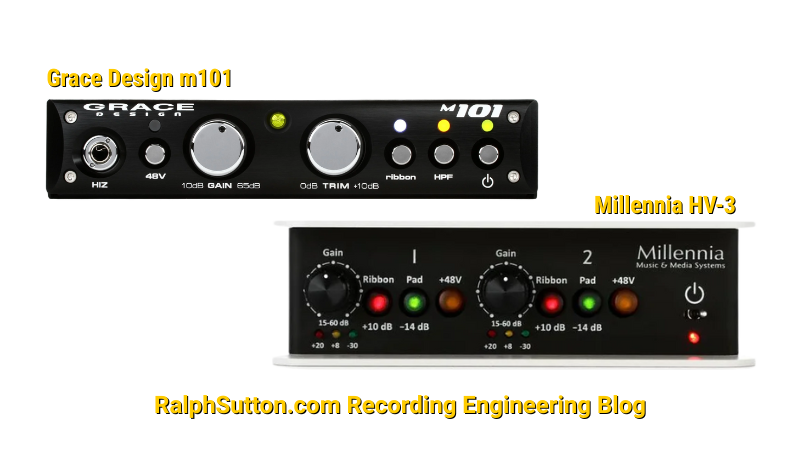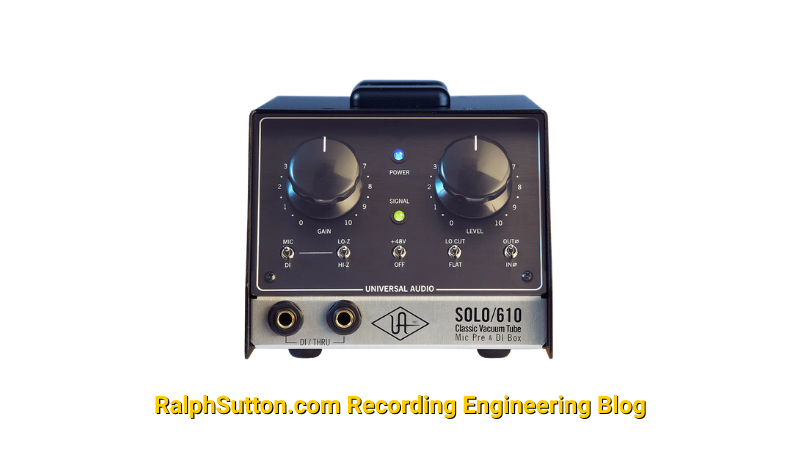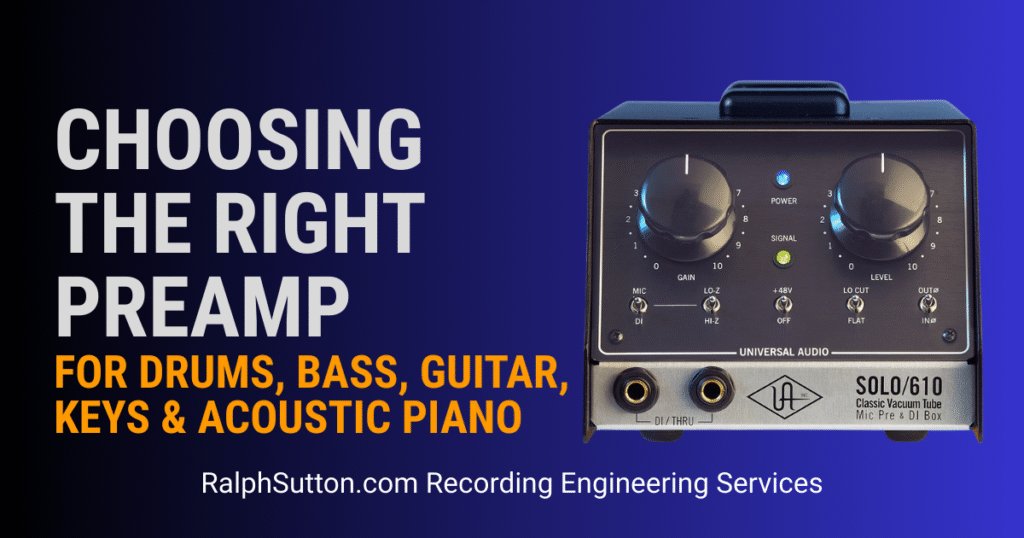🎛️ Choosing the Right Preamp for Drums, Bass, Guitar, Keys, and Acoustic Piano
By Ralph Sutton – Elite Recording Engineer | RalphSutton.com
Capture the Soul, Not Just the Signal
If you’re serious about capturing world-class recordings in your project studio, it’s time to get real about preamps. The preamp is not optional, it’s your first tone shaper after the mic or DI. It determines whether your signal comes in hot, clean, rich, or flat-out uninspired.
You could have the best musicians, the finest instruments, and killer mics, but if your preamp is cheap, generic, or mismatched, you’ve just thrown a blanket over your sound before it even hits your DAW.
This post is for musicians, indie producers, and engineers running tight setups with big vision. I’m going to break down what preamps I use for drums, bass, electric and acoustic guitar, keyboards, and acoustic piano, and more importantly, why they matter.
Let’s get into it.
🎚️ Section 1: Why Preamps Matter
It's More Than Volume. It's Vibe, Tone, and Trust.
A preamp doesn’t just make your signal louder. It defines the character of your sound before anything else touches it. Before EQ, before compression, before reverb or plugins, the preamp shapes how your source feels.
So, what is a preamp?
It’s a gain stage. It takes the weak signal from a mic, DI box, or instrument and boosts it to line level, the standard strength your recording interface or mixer expects. But a great preamp does more than boost. It adds tone, color, and dimension.
Cheap built-in interface preamps can sound clean, but sterile. Track after track recorded this way will sound small and lifeless.
Great preamps like a Neve 1073, API 512c, or UA 610-B saturate harmonics, tighten transients, and bring out musical detail that plugins struggle to recreate.
If you’re mixing recordings from a poor preamp, you’re fixing problems instead of enhancing greatness. Whether you’re recording drums, bass, guitar, keys, or acoustic piano, your preamp choice sets the tone.
🎙️ A Quick Note on Session Context
In many of my sessions, I’m working on vintage analog recording consoles like the Neve 8078 or the Trident A Range, which have their own built-in Class A preamps. These consoles are legendary for a reason they shape the sound before anything else hits the tape or DAW.
That said, I know most indie creators and project studio owners aren’t tracking on consoles like these every day.
So in this post, I’ve broken down standalone preamp options that emulate or mirror the tone and function of what I use in high-end studio environments.
If you’re not recording on a vintage Neve or Trident console, these preamps will help you capture high-grade sound that holds up in any recording or mix.
🥁 Section 2: Best Preamps for Drums
Capture the Impact, Not Just the Noise
Drums are unforgiving. If your preamps choke the transients or flatten the punch, your whole recording and mix will suffer.
Kick & Snare: API 512c or 312-style Preamps
Why I Use It:
API preamps bring fast transient response, tight low-end, and a forward midrange that helps kicks and snares punch through. They’re aggressive without being brittle.
Perfect For:
Inside kick mics (D112, RE20)
Snare top and bottom (SM57, AKG 451B)

Overheads & Room Mics: Neve 1073 or 1084
Why I Use It:
Neve preamps bring depth, warmth, and harmonic richness that makes cymbals shimmer and the room sound natural.
Perfect For:
Stereo overheads
Ambient room mics
Jazz, Funk, or Soul drum kits

Toms: Grace Design m101 or Millennia HV-3
Why I Use It:
These preamps are clean, fast, and transparent. They allow the tone of the drum and mic to speak clearly.
Perfect For:
Rack and floor toms
Percussion with nuance or detail

Can't Afford These Yet? Rent Them.
Not everyone is doing sessions at EastWest or The Village, but that doesn’t mean you can’t get world-class sound. You can rent all of these preamps in L.A. from:
🎸 Section 3: Best Preamps for Bass Guitar
Round Tone, Tight Bottom. No Mud, No Guessing.
Bass is the foundation. If it’s weak, the whole recording and mix will suffer. Great preamps help you capture the clarity, punch, and weight that plugins alone can’t restore.
Direct Signal (DI): Avalon U5 or REDDI Tube DI into API 512c
Why I Use It:
The DI captures the pure tone. The API adds punch and definition. Avalon = clean and hi-fi. REDDI = warm and blooming.
Perfect For:
Funk, jazz, soul, and hip-hop basslines
Active or passive bass guitars
Synth bass with analog bite

Mic’d Amp: Neve 1073 or UA 610-B
Why I Use It:
Neve adds harmonic texture and body. UA 610-B smooths out edges with tube warmth.
Perfect For:
Soul and R&B
Rock, funk, or layered tones
DI + mic blend setups

My Technique:
Blend DI through the API with a mic’d cab through the Neve or UA 610-B. It gives me clarity, depth, and mix control.
Don’t Own It? Rent It.
Same vendors — Hollywood Sound, PRO Studio Rentals, Capital Audio Rental — offer all of this gear.
🎸🎹 Section 4: Best Preamps for Guitar, Keys, and Acoustic Piano
Make It Sing, Not Sizzle
These instruments often get overlooked, but they’re full of tone and deserve the same front-end quality.
Electric Guitar (Amped): Royer R-122V or SM57 into Neve 1073 or API 512c
Why I Use It:
Neve gives warmth and midrange smoothness. API adds punch and focus.
Perfect For:
Amped clean or dirty guitars
Funk rhythms and lead tones
Acoustic Guitar: Neumann KM84 or TLM 103 into Grace Design m101 or UA 610-B
Why I Use It:
Grace keeps the tone honest and detailed. UA 610-B adds body without haze.
Perfect For:
Strumming, fingerstyle
Nylon-string recordings
Solo acoustic tracking
Keys & Synths: DI + Millennia HV-3 or API 512c
Why I Use It:
Millennia = ultra-clean and neutral. API = grit, excitement, and edge.
Perfect For:
Rhodes, Wurli, Clavinet
Modern synth layers
Any keyboard needing vibe
Acoustic Piano: TLM 170 R into Grace m101 or UA 610-B
Why I Use It:
A high-low mic pair on treble and bass strings, fed through Grace for transparency or UA for warmth. This setup preserves detail and delivers tone with depth.
💡 Section 5: Wrap-Up and Buying Advice
Get the Most from Your Setup — Even on a Budget
If you can only afford one preamp right now, buy the most versatile one you can. Look for:
Clean gain with low noise
High headroom
Optional color (transformers or tubes)
Compatibility with dynamics, condensers, and ribbons
My picks:
API 512c for punch and presence
Grace Design m101 for detail and clarity
Neve 1073 for vintage tone and warmth
Not ready to buy? Rent the right preamp for your next session.
❓ Frequently Asked Questions About Studio Preamps
1. What exactly does a preamp do in a recording setup?
A preamp boosts your mic or instrument signal to line level and adds tone, clarity, and harmonic depth that shapes your final recording.
2. Do I need different preamps for every instrument?
No. But you do need to understand how each preamp reacts to different sources. Choose wisely based on what you record most.
3. Can I still get great results without expensive preamps?
Yes. Use good mics, smart placement, and rent gear when needed. Your front end matters — but it doesn’t have to break the bank.
4. What’s the best preamp for drums in a home studio?
The API 512c is excellent for punch. Use a Neve 1073 on overheads and Grace m101 on toms or percussion for detailed clarity.
5. Should I use a preamp with keyboards or synths?
Absolutely. Even line-level sources benefit from saturation and tone shaping. Preamp choice adds vibe and mix placement.
6. Where can I rent pro-level preamps in Los Angeles?
Top rental options include Hollywood Sound Systems, PRO Studio Rentals, and Capital Audio Rental.
📍 Ready to Take Your Sound to the Next Level?
If you’re serious about leveling up your recording or mixing, I can help.
✅ I offer high-end Recording, Mixing, and Production Services
✅ I also consult on session setups and gear choices
➡️ Book a session or consultation at RalphSutton.com
➡️ Download the free guide: Top Preamps for Indie Creators (Coming soon)
